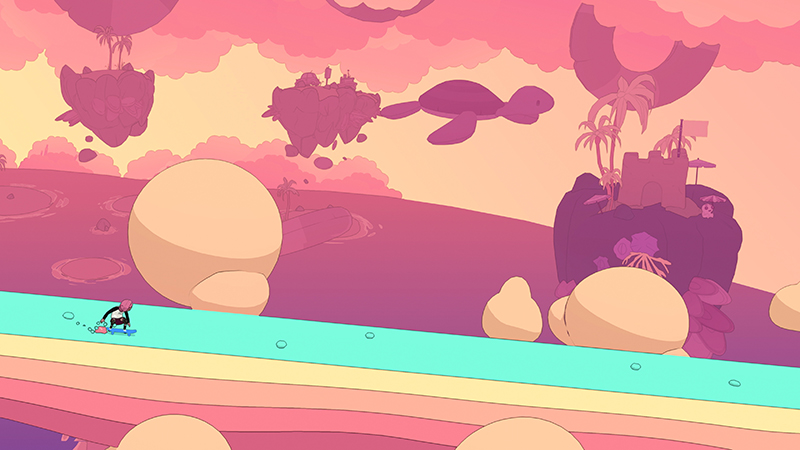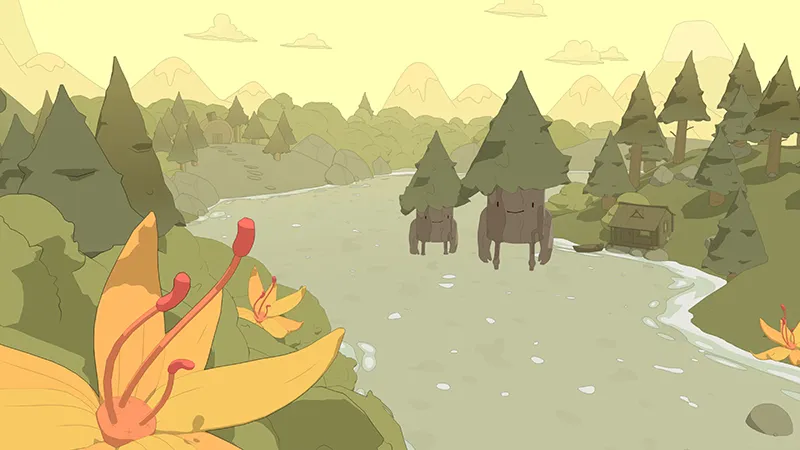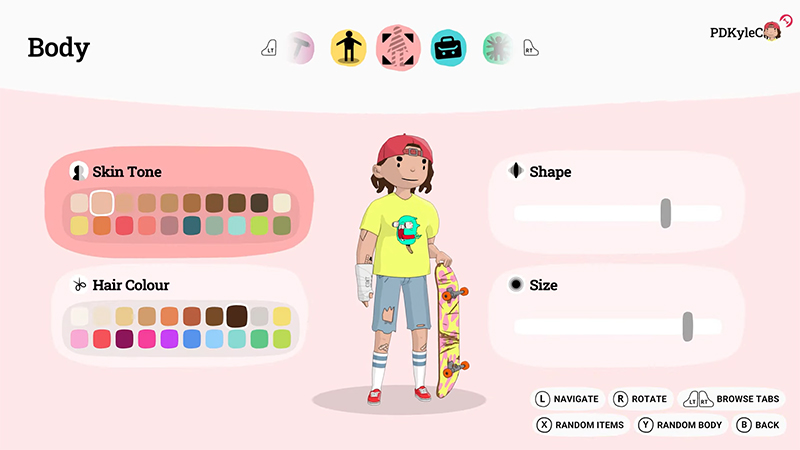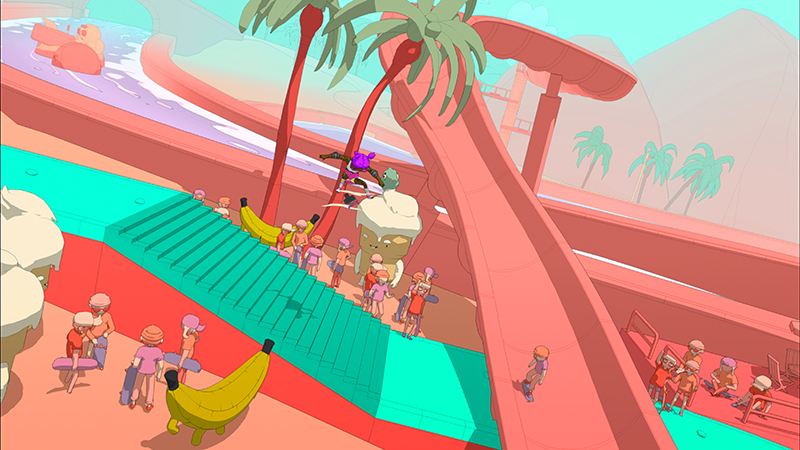OlliOlli World is almost out and is the ultimate OlliOlli game. It’s seemingly got everything an OlliOlli player would want and then some. Co-CEO Simon Bennett and Creative Director John Ribbins recently chatted with Senior Gaming Editor Michael Leri (once again) to talk about this ambitious game, its DLC, and how it feels to finally get their biggest title across the finish line without burning out.
ComingSoon: How does it feel to have finally finished OlliOlli World?
John Ribbins: It’s amazing, actually. We were chatting just before this about the first game. Obviously, finishing this is awesome, but we were thinking all the way back when it was a prototype. We were joking that the first game was a year of arguing while we not only figured out how to make the game, but also how to make video games in general. It’s been great to do the most ambitious thing we’ve made and probably the best thing we’ve made. But it was also great for this process this time around to not be a three-year-long argument. It’s actually been a really enjoyable journey.
It’s a really fantastic team that we had for OlliOlli World. It’s been so cool to have so many creative minds in the room and people who are really dedicated to the project and are able to put in so much love and effort and have really driven the process. It’s still a small enough team that I think everyone can see elements of their work in the game. You can sort of see little bits of everyone’s flavor, whether that’s the sound design and the attention to detail in that or all of the little touches the artists put in through the levels; all these tiny little things to notice that hopefully make you smile.
There’s so much love and care that everyone put into it and to get to the end of the project and [feel like that way is great]. Maybe I’m tempting fate, but I chat to other other developers who finish their games and you’re like, “What weren’t you happy with?” And they’re like, “No, I was happy with that. We made the thing we wanted to make.” And I’ve always been like, “What is that like?” Because we always get to the end and I’m like, “Oh man, is it good? I don’t know.” But I’m really happy with this one. So it’s probably the first game we’ve got the end of one where I was like “I’m psyched on this. I think we did a cool thing.”
Simon Bennett: From my perspective, we made a game that was way beyond our ambitions previously and it was way beyond what I think we could have ever achieved without such an amazing team. Like John mentioned, the people that we’ve got on have built something that’s just so remarkable and so different and so visually striking that every time I pick it up and play it, I smile.
I definitely can’t say that at the end of any other project that we’ve had. I usually get to the end of the project and I’m tired. We’ve been crunching. We haven’t [been crunching] on this one, but I’ll pick [one of our old games] up and I’ll just see all of the mistakes. And all I see with this is that we made the game we wanted to make and we have to thank Private Division, our publisher, for helping us get the time, resources, and trust to actually make that game. And I think this is the first time that we’ve had that as well, which is great.

It is a little harder to mess up in OlliOlli World. You can land without pressing anything and be fine and it’s a little harder to wipe after beefing a spin. Can you speak to smoothing over those kinds of things and why those decisions were made?
Ribbins: We had a pillar of trying to make the game welcoming. We tried to make the game more accessible to people. I feel like that ended up infusing into a lot of things like the story in the art. Being welcoming ended up being part of that, too, but it was core to the design philosophy. And I think the big change we made was instead of punishing you for doing the things we don’t want to do, we wanted to just reward you more for doing the things we do want you to do. Like instead of being like, “You didn’t press A, so we’re gonna mess you up and make you fall over.” We’re like, “Well, you didn’t press A, so you just don’t get as many points.”
But if you press A, you get a perfect landing, you get more score, you keep your combo going, and so on. Like with the spins, it was like, “Do we need to make you slam for not landing the spin? We could just give you less score.” And if you are the kind of person that really cares about finishing a level in one combo, landing everything perfectly, and getting the highest score, you still have to care about those things and be just as hardcore about them as you were in the last two games.
But if you are someone who just wants to enjoy cruising through the level and having a good time, we’re not gonna punish you for not caring about those things either. I think that was probably the biggest fundamental change we made to the game. It’s a difficult line to tread. If you enjoyed the previous two games and you were really hardcore about it, it’s not gonna make much of a difference to you because you’re still gonna keep going for all those perfects. For all those other people that were just like, “How do I play this game?” Hopefully they have a slightly better time this time around.
OlliOlli World feels like the ultimate OlliOlli game since there’s customization, endlessly generated levels, a nice helping of new mechanics, multiple multiplayer options, and more. Was that a conscious choice? And how do you expand while still keeping in mind your team size and team health?
Bennett: I think when we got to this project, we’d just finished Laser League. So the team had around 35 people and then it subsequently sort of got slightly smaller as we ramped down, but we’d had bigger ambitions for Laser League. We’d done more as a studio. We’d done synchronous online multiplayer and customization. We learned a lot of chops from that title.
And when we came to OlliOlli and when we made the decision to call it OlliOlli World, I think it’s a statement. It’s a big statement to call it OlliOlli World. It’s a reimagining of the series and the franchise, rather than the sequel. I like to think of it as the ultimate OlliOlli. It’s a love letter to skateboarding and it’s a big title and it always had to have that scope that you talk about. It always had to have more than we’d done. And we always want to push ourselves as a studio and not stay within our safe box. And as a result, we’ve got OlliOllli World. It’s a huge game. There’s so much content. I think if you like OlliOlli, you’re just gonna be playing this game for most of this year. Maybe most of next year as well.

How does that ambition to keep pushing also work with not overworking or biting off more than you can chew?
Bennett: I think it’s just like we had more time and we had more resources. It was a bigger team.
Ribbins: We grew quite slowly over the course of development. In terms of the scope of the project, I think one thing that was interesting with this was coming in was we knew what OlliOlli was. We have that core bit of the game. And actually in the first nine months, we tried loads of things. If this game was shipping with all of the stuff that we tried out in the first nine months, it would just be horribly bloated, but it would have loads of stuff, like quests that pop up on a daily basis or like all of these other things.
Because like Simon said, we wanted to do the ultimate OlliOlli so what does that mean? We know what it means from a gameplay side, but for all of that other stuff, it was very experimental. We tried loads of things and we kind of ended up with this big bloated project. And then we went, “What ones of those actually accentuate the experience? What things actually make it better?” And then did a huge descope and really focused on polishing those bits.
And I think that was the right way to go, but I’m glad we didn’t do a lot of the other things that we tried for the first nine months because some of them were cool, but they just felt extra to the experience. And then balancing that up with who we had and what we wanted to make and asking if we could do that in a way that means everyone has a great work-life balance and can enjoy the process of making this thing while making something cool was really important to us from the start.
The other two OlliOlli games did not get traditional DLC, but this game is set to get two expansions. Why did you want to do that?
Bennett: Prior to World, we had the best fun when we were making DLC for Not a Hero and when we were making DLC for OlliOlli2. It’s the point in the game at which you’ve stopped with most of the core part of the game and all of the rules there. Everyone knows what the game is. You had a bit of a break and you get to come back to it and the ideas that you weren’t able to put into that core game and you’re able to continue developing them. And when you are able to continue developing them after launch with all of the learnings and all the knowledge of what people are asking for, that’s like the dream dev point.
The DLC is insane. The team has just taken everything they’ve learned and just gone to that next level. It’s like the wheels are off a little bit.
So… hoverboards?
Ribbins: The wheels are still on the boards. We haven’t gone hoverboards. We couldn’t get the Back to the Future license. [laughs] Simon’s right. It’s nice when you’ve built the toy box and you’ve figured out what the toys are and it’s actually really nice to have some time to play with all the toys we’ve made. I don’t want to say too much, but I hope that where we’ve gone with this is a fun expansion and has some new stuff to do once you’ve mastered what’s what’s there in the core game.
So what can we expect with the DLC?
Ribbins: I think the real answers we’re gonna give you are really politician’s answers. I’m sorry about that. [laughs]
Bennett: Our overlords are listening, Michael. [laughs]
Ribbins: I can guarantee there’s a void and people will ride it and that is as far as I can go.

What do you think is the biggest or best change in OlliOlli World?
Bennett: The biggest change for me is just the core gameplay, the flow of that core gameplay, and the way that we’ve managed all of the physics. The way that it feels to play is the ultimate OlliOlli. There’s just something weighty about it, something solid, something visceral, and something that I just get hooked in and play for hours and hours and hours. It feels like the best OlliOlli that we’ve made. And I hope that more people get to feel that.
Ribbins: I’m really torn because in a world where there are third-person games and you can walk in every single direction, being like “You can go right to left” kind of sounds like a mental thing to say like it’s a groundbreaking thing you can do in the game. But actually being able to go right and turn around and come back the other way and do looping levels or just levels that are more complicated is great.
Like in OlliOlli2, the only way we could do branching was to branch vertically. And you have these paths that just go off and being able to actually have levels that are expansive and go towards the camera and being able to have sections where you can go the other way and loop back and come back to where you were before is fantastic. When we were in early prototyping and I got to mess around with level design, that was the exciting thing as a designer to be able to play around with. And I know that that has given the designers so much more scope to build interesting levels.
And if I can be cheeky and have two, the other one would be customization. I waste so much time in customization, just pressing X and looking at all the different random combinations even though I know everything that’s in there. I still get a kick out of making a new look for my character. I found the other day a really early prototype of customization for the first OlliOlli with the pixel art character. And it was always beyond our reach for what we could do in the first two games, but it was something that was on our wishlist since the first game. And so getting that in and getting it in to the extent that we’ve got it in, with all of the things that you can unlock and customize, I’m really happy with it.











